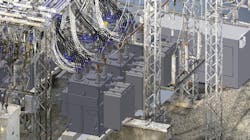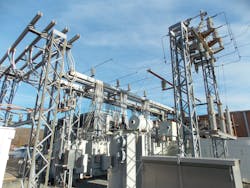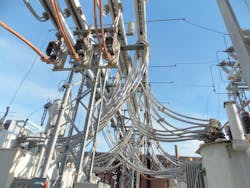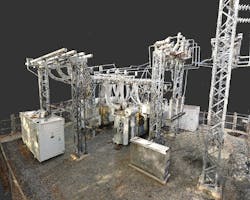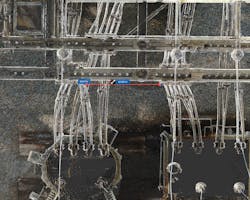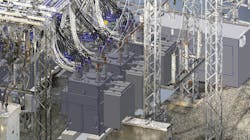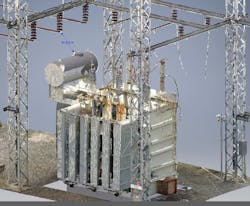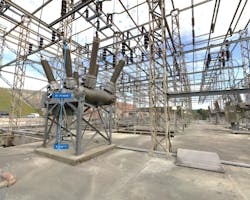3-D LiDAR Sees Beyond Traditional Methods
Historically, light detection and ranging was used by utility engineers to aid in the design of transmission lines. The use of this technology has since been expanded to other areas that needed the same level of detail and accuracy, including substations. Duke Energy’s first use of 3-D scanning in a substation showed how useful this technology can be. The utility had an industrial customer substation — with two parallel banks of single-phase transformers — that was very congested and heavily loaded.
During routine substation maintenance, Duke Energy identified transformer equipment that needed to be replaced to avoid a potential unplanned outage for a large industrial customer. Because the transformers at this station were operating near capacity, the utility decided to upgrade them to new, higher-capacity equipment. The challenge was the new transformers had a larger footprint, yet the substation was already very congested. It was critical to ensure adequate clearance from other equipment. With only hand-drawn plans of the substation, Duke Energy looked to 3-D laser scanning to design an accurate model of how the new transformers would fit in the substation.
A Virtual View
The large industrial customer served by this substation normally operates 7 days a week 365 days a year, making an extended outage to replace the transformers challenging. Duke Energy worked with the customer and agreed on a four-day outage to complete the replacement. The customer requested the outage occur during the month of December, giving the utility only five months to special order the transformers from the manufacturer and prepare for the work.
The transformer manufacturer said it could build and deliver seven new transformers (six for the two parallel banks and one for a spare) by the December outage. Knowing these new transformers would have a larger footprint, it was important to ensure adequate physical and electrical clearance from other equipment in this very congested substation. Like many older stations, this site only had photocopies of hand-drawn plans.
Therefore, to ensure planning accuracy, Duke Energy decided to make a 3-D model of the low-side bus, support structures and transformers in the station. With the station being energized, it would be impossible to get accurate physical measurements on each of the conductors. Some of these conductors were only inches away from the steel. The utility knew if the new transformers were much larger, it would have a problem routing the conductors to the transformer bushings.
During this same time frame, a vendor provided a demo of its 3-D laser scanner. The scanner generated millions of data points in a 3-D point cloud that could be measured individually or between any of the points. The 3-D point cloud also could be rotated, flipped, turned, walked through and viewed from any angle. Duke Energy saw the value and moved forward with it.
After scanning the industrial customer’s station, the utility accurately modeled where each conductor was attached to the low-side bus. When the drawings of the new transformers arrived, Duke Energy integrated them with the model of the low side of the station. Using the 3-D model, the utility determined the conductors would still work within the new transformer footprint. It also integrated the 3-D model of the low side with new transformers into the 3-D scan of the whole station, providing a true virtual view of how the new transformers would fit in the station. This new perspective also identified a new challenge.
The new transformers were designed differently from the old ones. The new transformers had a pressure-relief valve downspout that required the transformers to be spaced farther apart. With this adjusted spacing, the 3-D model indicated one of the pipe downspouts was making contact with a capacitor house next to the transformer banks. And on another transformer, the control box was about 1 inch (25 mm) directly across from an ac control box mounted on a support column, making it impossible to open the door on either box.
Using the virtual model, it was determined rotating the downspout 45 degrees would provide more space and enable the transformers to be placed even closer together to give the needed clearance from the capacitor house. Also, by relocating the control box on the transformers, Duke Energy would be able to get the clearance needed to open the doors on both the transformer and the ac control box. This early previsualization allowed the utility to provide the manufacturer with the specifications needed to make the necessary modifications.
The four-day outage also was creating a planning challenge, given the large work scope of the project. Unhooking and removing six transformers, replacing the foundations, connecting the new transformers and testing them would create significant work in a short period of time. This customer had one delivery point and no backup generation. If something went wrong during the outage and caused a delay, there would be no way to get their power back on in the four days allotted for the outage. Fortunately, 3-D scanning and a virtual blueprint helped to ensure everything worked exactly as planned. The project even finished ahead of schedule.
Further Uses
Another advantage of the 3-D point cloud is it can be copied and placed into another scan. An example of this occurred when a substation transformer bank failed and needed a quick replacement. A transformer of the same voltage was available at another station and not in use. This transformer was from a different manufacturer and had a different design than the failed transformer, including an oil conservator tank that was in a different position.
A 3-D scan of the failed transformer bay and the proposed replacement transformer helped to address initial clearance concerns. Replacing the transformer in the virtual model first enabled Duke Energy to get clearance measurements from the oil conservator tank to the existing bus, which improved planning and helped to ensure materials were available to rework the bus.
An unforeseen use of 3-D laser scanning has been in the scoping of projects. Typically, when a project is identified, a developmental team is sent to scope the project. This work often can involve a large group of people traveling several hours to the job site to take notes and photographs. In addition to a 3-D point cloud, laser scanning provides high-resolution photographs overlaid on top of the 3-D point cloud. Switching to the photo view provides a full 360-degree, high-resolution photo of the area scanned, allowing the viewer to virtually stand in the station. The 3-D point cloud remains embedded within the photo and measurements can be taken from the photo view of any object in view.
Now, by using a 3-D scan of the station, the developmental team can scope the station without having to make a site visit, saving time and travel expense. The scan also gives the project team access to the data cloud any time to address questions and virtually revisit the site as often as needed.
Acknowledgements
The authors extend special thanks to Buddy Rogers, the senior vice president of Transmission C&M; Mick Vander Ploeg, general manager of Transmission Asset Management; Saurabh Vyas, Stephen Wood, Engineering Managers and Rhonda Brooks, general manager of Project Management; for identifying and supporting alternative use cases for this 3D scan technology in Transmission business operations. Thanks also goes to Jason Handley, director of emerging technology office for continuous support and guidance in identifying latest technologies for grid improvement initiatives.
SCOTT MCSWAIN is a senior engineering technologist in the Transmission Asset Management Technical Support group at Duke Energy. He has more than 35 years experience in the Transmission Substation department. His job includes providing various forms of technical support and solutions for substation construction crews and substation design/engineering. He has a passion for utilizing and sharing new 3D technology.
SHIVA KORREMLA is a lead engineer at Transmission Innovation and Business Transformation group with 14 years of experience and is a
licensed engineer in the state of North Carolina. He has a breadth of Transmission engineering experience with a technology slant to identify lateral uses of single use focused technology initiatives. He received master’s in mechanical engineering from the University of Texas.
CHRISTY PETIT GUENTHER is the leader of Transmission Innovation and Business Transformation group at Duke Energy. She has 29 years’ experience in leading several critical and complex initiatives with strong track record. Her role is to lead the Innovation and Business Transformation team at Duke. That is to use creative ways to solve problems through a human centered design approach. She received a BS in Industrial Management from The Georgia Institute of Technology.
GARRY SIMMS is a transmission tech support manager at Duke Energy. Sims has 41 years’ experience with Duke Energy in a variety of engineering and leadership roles. He received BS in Electrical Engineering from North Carolina State University and is a licensed engineer in North and South Carolina.
About the Author
Shiva Korremla
SHIVA KORREMLA is a lead engineer at Transmission Innovation and Business Transformation group with 14 years of experience and is a licensed engineer in the state of North Carolina. He has a breadth of Transmission engineering experience with a technology slant to identify lateral uses of single use focused technology initiatives. He received master’s in mechanical engineering from the University of Texas.
Scott McSwain
SCOTT MCSWAIN is a senior engineering technologist in the Transmission Asset Management Technical Support group at Duke Energy. He has more than 35 years experience in the Transmission Substation department. His job includes providing various forms of technical support and solutions for substation construction crews and substation design/engineering. He has a passion for utilizing and sharing new 3D technology.
Christy Petit Guenther
CHRISTY PETIT GUENTHER is the leader of Transmission Innovation and Business Transformation group at Duke Energy. She has 29 years’ experience in leading several critical and complex initiatives with strong track record. Her role is to lead the Innovation and Business Transformation team at Duke. That is to use creative ways to solve problems through a human centered design approach. She received a BS in Industrial Management from The Georgia Institute of Technology.
Garry Simms
GARRY SIMMS is a transmission tech support manager at Duke Energy. Sims has 41 years’ experience with Duke Energy in a variety of engineering and leadership roles. He received BS in Electrical Engineering from North Carolina State University and is a licensed engineer in North and South Carolina.
